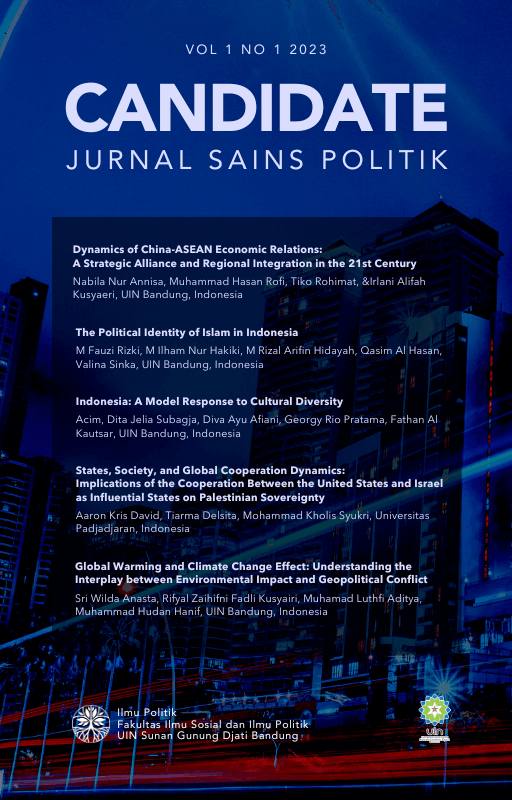Dynamics of China-ASEAN Economic Relations: A Strategic Alliance and Regional Integration in the 21st Century
Keywords:
Political Cooperation, Economic Integration, RegionalismAbstract
This study investigates the multifaceted nature of the China-ASEAN economic cooperation, exploring its impact on global trade and financial sectors. It delves into the dynamics of this relationship, highlighting the strategic partnership and trade agreements like the ASEAN-China Free Trade Agreement (ACFTA) and the Regional Comprehensive Economic Partnership (RCEP). The research adopts a qualitative approach, analyzing data from various sources including academic journals and government documents to offer an in-depth understanding of the evolving China-ASEAN economic collaboration. Key findings illustrate China's growing investment in ASEAN, especially in infrastructure, manufacturing, and technology, fostering mutual economic growth and creating job opportunities. The Belt and Road Initiative (BRI) by China emerges as a significant factor in enhancing regional connectivity. Furthermore, the study explores the cooperation in innovation and technology between China and ASEAN, emphasizing the potential for technology transfer and joint research. The study underscores the bright prospects of the China-ASEAN economic partnership, emphasizing its role in shaping the global trade landscape. It also acknowledges the need to address challenges like political issues, economic competition, and environmental concerns to ensure a sustainable and mutually beneficial partnership.
Â
References
Banlaoi, R. C. (2021). Counterterrorism cooperation between china, asean, and southeast asian countries: Current status, challenges, and future direction. China Review, 21(4).
Bi, S. (2021). Cooperation between China and ASEAN under the building of ASEAN Economic Community. Journal of Contemporary East Asia Studies, 10(1). https://doi.org/10.1080/24761028.2021.1888410
Breu, F., Guggenbichler, S., & Wollmann, J. (2008). Agreement on Trade in Goods of the Framework Agreement on Comprehensive Economic Co-Operation Between the Association of Southeast Asian Nations and the People’s Republic of China. Vasa.
Damayanti, F., Putri, N. I. M., Wahyuni, R. S., Prayoga, M. R., & NW, G. K. (2018). ASEAN Di Tengah Rivalitas AS Dan Cina: Kerja Sama ASEAN Dengan RCEP Dalam Mengurangi Dampak Perang Dagang. Indonesian Perspective, 3(2), 145–158.
Ed Hirs. (2019). China is Betting Big on Increasing Oil Production. Forbes. Retrieved from https://www.forbes.com/sites/edhirs/2019/06/06/china-is-betting-big-on-increasing-oil-production/#510f83096371
Fenny Crosby Sinaga. (2017). Kepentingan Tiongkok terhadap Afrika melalui Forum On China-Africa Cooperation (FOCAC). JOM FISIP, 4(2).
Ferrianta, Y., Hanani, N., Setiawan, B., & Muhaimin, W. (2012). Impact of Trade Liberalization ASEAN-China Free Trade Area (ACFTA) on the Performance of Indonesia Maize Economy. J. Basic. Appl. Sci. Res, 2(7), 6801–6809.
He, M. (2021). Global Value Chain in the Post-COVID Era: Implications for Regional Cooperation of ASEAN and China. Open Journal of Political Science, 11(04). https://doi.org/10.4236/ojps.2021.114047
Hennida, C., Wardhana, A., Sahab, A., Saadah, K., Pratiwi, F. I., & Ratmoko, E. (2020). Respons Negara-Negara Asia Tenggara Terhadap Dominasi China. Airlangga University Press.
Hutagalung, J. N. (2017). Dampak Kebijakan Politik Luar Negeri China Terhadap Kepulauan Natuna di Laut China Selatan. Universitas Sumatera Utara.
Jianren, L. (2016). The 21st century maritime silk road and China-ASEAN industry cooperation. International Journal of China Studies, 7(3).
Julia Breuer. (2017). Two Belts One Road? The Role of Africa in China’s Belt Road Initiative. Stiftung Asienhaus. Retrieved from https://www.asienhaus.de/uploads/tx_news/Blickwechsel_BRI-Afrika_01.pdf
Kennedy, P. S. J., Sutrasna, Y., & Haetami, H. (2022). Geo-ekonomi: Dampak Terbentuknya Pakta Trilateral AUKUS terhadap ASEAN. Journal of Business and Economics Research (JBE), 3(2), 108–116.
Kompas. (2020, December 15). CAFTA: Sejarah, Tujuan Dan Program. Retrieved from https://www.kompas.com/skola/read/2020/12/15/090000869/cafta---sejarah-tujuan-dan-program#
Kulesa, Å., Madej, M., Wyciszkiewicz, E., & Gradziuk, A. (2010). Implications of ASEAN-China Free Trade Agreement (ACFTA). Bulletin, 8(884).
Ling, W. (2021). Creating Strategic Opportunities: The Concept and Practice of China-ASEAN Security Cooperation. Social Sciences in China, 42(3). https://doi.org/10.1080/02529203.2021.1971406
Maulana, M. R. (2021). Perjanjian Kemitraan Ekonomi Komprehensif Regional (Regional Comprehensive Economic Partnership-RCEP) Dan Pengaruhnya Untuk Indonesia. JISIP (Jurnal Ilmu Sosial Dan Pendidikan), 5(1).
Meng, L. Y. (2017). “Sea of Cooperation†or “Sea of Conflict�: The South China Sea in the Context of China-ASEAN Maritime Cooperation. International Journal of China Studies, 8(3).
Santosa, B. (2013). Integrasi Pasar Modal Kawasan Cina - ASEAN. Jurnal Ekonomi Pembangunan: Kajian Masalah Ekonomi Dan Pembangunan, 14(1), 78. https://doi.org/10.23917/jep.v14i1.162
Simaltoga, J. (2022). Peranan Partai PDI-Perjuangan Dalam Membangun Etika Politik.
Wilantari, R. N., Oktaviana, F., Santoso, E., & Yunitasari, D. (2020). Ketidakpastian Kebijakan Ekonomi China dan Pertumbuhan Ekonomi Indonesia. BISMA: Jurnal Bisnis Dan Manajemen, 14(2), 147–154.
Downloads
Published
How to Cite
Issue
Section
License
Authors who publish with this journal agree to the following terms:
- Authors retain copyright and grant the journal right of first publication with the work simultaneously licensed under a Creative Commons Attribution-ShareAlike 4.0 International License that allows others to share the work with an acknowledgment of the work's authorship and initial publication in this journal.
- Authors are able to enter into separate, additional contractual arrangements for the non-exclusive distribution of the journal's published version of the work (e.g., post it to an institutional repository or publish it in a book), with an acknowledgment of its initial publication in this journal.
- Authors are permitted and encouraged to post their work online (e.g., in institutional repositories or on their website) prior to and during the submission process, as it can lead to productive exchanges, as well as earlier and greater citation of published work (See The Effect of Open Access).





.jpg)



